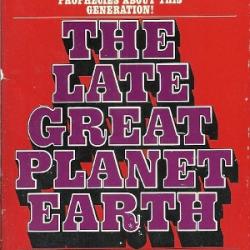Tribulation Force, pp. 440-443
When we last saw our heroes they were in a dire predicament. Traffic leading up to their exit of the tollway was at a standstill and it seemed they would have to exit onto Route 53 and then backtrack for miles.
Oh, and also Washington, D.C., has been destroyed.
Still stuck in traffic, they desperately try to find a local news station:
“Put in on ‘scan,'” Chloe suggested. Finally the radio found an EBS station and Amanda locked it in.
I hope that by quoting only a couple of sentences from that section I haven’t made it seem less dramatic, because this is one of the most dramatic searching-for-the-news-on-a-car-radio scenes in any book in recent memory.
A Cable News Network/Global Community Network radio correspondent was broadcasting live from just outside Washington, D.C. “The fate of Global Community Potentate Nicolae Carpathia remains in question at this hour as Washington lies in ruins,” he said. “The massive assault was launched by east coast militia, with the aid of the United States of Britain and the former sovereign state of Egypt, now part of the Middle Eastern Commonwealth.”
Those expository little tidbits about the shape of the new confederations under Nicolae Carpathia’s one-world government are useful information. Sticking them into the middle of a news report on the outbreak of World War III, however, may not have been the most artful way of conveying that information to readers.
The remarkable thing here, though, is what doesn’t happen in this scene. Buck Williams is the publisher, top editor and star reporter for Global Community Weekly, yet he gives no thought to getting in touch with his office. I don’t know what the Weekly had planned for it’s next cover story, but I’m thinking the destruction of Washington, D.C., might require a change of plans. Yet like everyone else in the car, Buck just sits passively, listening to the CNN radio (?) report. He doesn’t frantically pull out his cellphone to call his close friends Steve Plank or Chaim Rosenzweig to get the inside scoop on the biggest breaking news story since the Event itself.
Yes, I realize that Buck doesn’t have a cellphone. We’ve discussed that before, but since then 18 months have elapsed in our story and Buck has been promoted to his new position as one of the world’s media elite. In 1996, when Tribulation Force was first published, cellphones were not yet as ubiquitous as they are today, but surely the publishers, top editors and star reporters for Time and Newsweek had them.
Again, though, the really strange thing here is not that Buck Williams does not have a cellphone. The really strange thing here is that Buck Williams isn’t wishing that he had a cellphone as he sits, stuck in traffic and unable to do his job as the biggest story in the world unfolds.
The CNN radio report continues:
“Global Community peacekeeping forces immediately retaliated by destroying a former Nike center in suburban Chicago. Reports from there indicate that thousands of civilian casualties have been reported in surrounding suburbs, and a colossal traffic tie-up is hampering rescue efforts.”
“Oh, dear God!” Amanda prayed.
It’s not altogether clear there whether Amanda’s prayerful cry is due to the news of the thousands of casualties or to the news about the scope of the traffic jam.
The hilarious awfulness of the mention of that traffic jam — by this reporter in this context — takes a moment to sink in. This reporter, remember, is broadcasting live from the outskirts of what used to be Washington, D.C. That city now “lies in ruins,” and this reporter is braving the chaos, flames and destruction to bring us the first heart-stopping account of that astonishing, horrifying news. And somehow he manages to work in a reference to the very traffic jam our heroes are sitting in.
One might imagine that the destruction of the former American capital might also lead to a “colossal traffic tie-up” all along the East Coast, and that this might also “hamper rescue efforts” in that city of 600,000 people. The reporter, on the scene there in Washington after somehow navigating that traffic himself, makes no mention of that. Yet from the front lines of World War III, he reports on traffic conditions a thousand miles away.
We’ve often discussed the staggering self-absorption of the main characters in these books. It’s hard to feel much sympathy for Buck and Rayford when they act as though the world revolves around them. But they can’t help it, because thanks to the authors, their world does revolve around them. Nothing matters to the authors except that which directly affects our heroes. No one matters except those who directly affect our heroes. If Buck and Rayford don’t care about someone then they authors don’t care about them either, and vice versa. And we readers are expected to share this disregard.
The reporter babbles on a bit about some other news from the second seal of the apocalypse:
“Other attacks we know about at this moment,” the reporter went on, “include a foray of Egyptian ground forces toward Iraq, obviously intending a siege upon New Babylon. That effort was quickly eliminated by Global Community air forces, which are now advancing on England.”
The Egyptians’ planned siege might have worked, too, if only the Antichrist’s fighter jets hadn’t destroyed their battering ram.
These strange and random-seeming little details of the war are included because, according to Tim LaHaye, they fulfill “Bible prophecies.” In this case, I think it has something to do with Ezekiel 30:10: “I will also make a multitude of Egypt to cease by the hand of Nebuchadnezzar king of Babylon.” LaHaye’s strictly literal interpretive scheme, of course, means that this doesn’t refer to Nebuchadnezzar, king of the Neo-Babylonian Empire from 605-562 BCE, but rather to the future Antichrist who will create a global capital on the site of the ruins of that empire. And, obviously, the proper chronological reading of scripture is to locate the events described in Ezekiel 30:10 as occurring immediately after the events described in Revelation 6:4. Obviously.
Once it seems clear that the intrepid radio reporter isn’t going to provide any further information about the traffic in suburban Chicago, our heroes lose interest in his account of the outbreak of global conflict and return their focus to more urgent matters:
“We’ve got to get to Bruce,” Chloe said, as Rayford inched along. “Everybody’s going to be taking 53 north, Dad. Let’s go south and double back.”
But then the reporter — the same reporter there on the outskirts of the rubble of Washington, D.C. — starts talking about the other urgent question on everyone’s mind all over the world: What about Nicolae Carpathia’s beautiful airplane?
“Global Community intelligence today uncovered a plot to destroy Potentate Carpathia’s plane, which may or may not have contained Carpathia when it was flown to O’Hare International this morning. That plane is now airborne, destination unknown, though Global Community forces are marshaling in New York City.”
At this point I’m almost surprised that the reporter didn’t say, “when it was flown to O’Hare International this morning by ace pilot Rayford Steele.”
Amanda grabbed Rayford’s arm. “We could have been killed!”
When Rayford spoke, Buck thought he might break down. “Let’s just hope I didn’t fulfill Earl’s dream by getting him killed,” he said.
“You want me to drive, Rayford?” Buck asked.
“No, I’ll be all right.”
Apparently Rayford is only just now realizing that when Nicolae asked him to fly the plane to Chicago as a decoy to mislead rumored insurgents, what he actually meant was that he wanted Rayford to fly the plane to Chicago as a decoy to mislead rumored insurgents.
Buck never got around to telling Rayford that those insurgents were more than a rumor. He had been told about the planned attack on Nicolae, and he knew just when it was going to occur, but somehow he forgot to mention any of that to his father-in-law, Nicolae’s personal pilot. Buck’s offer to drive seems like an awkward attempt to change the subject before anyone says something like, “If only we had had some way of knowing that insurgents were planning to attack Nicolae’s plane today …”
And then, abruptly, Jerry Jenkins decides to sprinkle in a misplaced, misbegotten and mishandled attempt at humor:
The radio announcer continued: “We’re on standby for a lie feed, excuse me, a live feed from Global Community Potentate Nicolae Carpathia …”
“He had that right the first time,” Chloe said.
The wit involved in constructing that joke and the evident pride in its execution makes me realize who it is that Jerry Jenkins frequently reminds me of: David Brent.
While waiting for the live feed from the leader of the world, the CNN radio reporter — still the same reporter — continues to neglect the carnage all around him in the smoldering ruins of Washington and, instead, adds more detail to his report on the Chicago suburbs:
“GC peacekeeping forces spokesmen say the destruction of the old Nike base was effected without the use of nuclear weapons. … There is, we repeat, no danger of radiation fallout in the Chicago area, though peacekeeping forces are not allowing automobile traffic near the site.”
I’m fascinated by the image of this reporter, standing on the outskirts of the shattered capital city but neglecting to report on that while compulsively discussing the traffic in Chicago. I’m imagining that this reflects some new technology in the “not-so-distant future” world of Tribulation Force.
Think about it, if we speculate about possible developments based on our current technology and cultural trends, we can imagine a world of the not-so-distant future in which “the news” would become a personalized, idiosyncratic stream of information tailored to each individual. In such a world, the “news” that you would read, hear or watch would be different from the “news” I would consume. It would be shaped to meet our personal needs and preferences, based on location (not just our addresses, but using GPS tracking in our phones, tablets, etc.), and based on a host of data mined from our browser histories, digital TV and radio habits, our social media “likes” and our responses to a steadily evolving series of interface surveys.
So if, in such a NSDF world, you were stuck in traffic due to the outbreak of World War III, your personalized news reports on the start of the war would be interspersed with practical information on your personal traffic dilemma.
If that were what Jenkins were portraying here, then the characters’ behavior and reactions would also make more sense. Because a story involving that sort of technological development wouldn’t be a story about technology, but a story about people — the kind of people such technology might foster and the kind of people who might incline toward such technology. It would likely be a satire chiding an increasingly self-absorbed culture of people stunted by a myopic epistemic closure. And while that isn’t the authors’ intent, it often seems like we’re reading that kind of satire.
But despite its being set in the not-so-distant future, Tribulation Force doesn’t include any such speculative creativity regarding possible technological or cultural changes. That results in a “future” that seems weirdly behind the times. It’s only been 15 years since the book was first published, but the future it describes already seems quaintly 20th-century.
Part of the blame for that rests with Jerry Jenkins, who doesn’t seem to have expended any real effort or imagination in creating the world of his novel. But I think the blame also has to be shared with his co-author and with their intended readership. Tim LaHaye would not have allowed any such inventiveness by Jenkins. And their intended readers would not have understood it.
Consider one of the classic clichés of “futuristic” possibilities: the flying car. If Jenkins had tried to give Buck Williams a flying car, LaHaye would have vetoed the idea. His “Bible prophecies” don’t say anything about flying cars, so flying cars cannot be permitted in this story. LaHaye allows some strange and largely unexplained future developments in these books — such as Rosenzweig’s miracle formula, or the even more miraculous peaceful quadrupling in size of the nation of Israel — but only when those developments are items from his prophecy check list.
That distinction is also what the intended readers of these books are expecting. Any additional creative touches from Jenkins would likely be interpreted by those readers as official parts of LaHaye’s “Bible prophecy.” If Buck Williams were allowed to zip around in a flying car, those readers would begin to view flying cars as a necessary sign of the Last Days. “But pastor,” they’d be saying, “we know the Rapture can’t come yet because we haven’t got flying cars.”
And that’s a shame. Because if you’re the greatest investigative reporter of all time and you’re hopelessly stuck in traffic while the biggest breaking news story in the world is unfolding a thousand miles away, then a flying car would probably come in handy.












